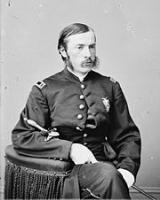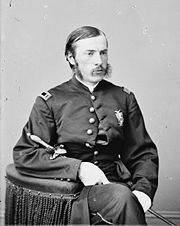
Charles Leale
Encyclopedia

American Civil War
The American Civil War was a civil war fought in the United States of America. In response to the election of Abraham Lincoln as President of the United States, 11 southern slave states declared their secession from the United States and formed the Confederate States of America ; the other 25...
.
He was the first doctor to be admitted into the presidential box at Ford's Theatre
Ford's Theatre
Ford's Theatre is a historic theater in Washington, D.C., used for various stage performances beginning in the 1860s. It is also the site of the assassination of U.S. President Abraham Lincoln on April 14, 1865...
on April 14, 1865 after John Wilkes Booth
John Wilkes Booth
John Wilkes Booth was an American stage actor who assassinated President Abraham Lincoln at Ford's Theatre, in Washington, D.C., on April 14, 1865. Booth was a member of the prominent 19th century Booth theatrical family from Maryland and, by the 1860s, was a well-known actor...
shot President Abraham Lincoln
Abraham Lincoln
Abraham Lincoln was the 16th President of the United States, serving from March 1861 until his assassination in April 1865. He successfully led his country through a great constitutional, military and moral crisis – the American Civil War – preserving the Union, while ending slavery, and...
in the back of the head with a Philadelphia Deringer pistol.
At the time, he was a 23 year old surgeon in charge of the Wounded Commissioned Officers' Ward at the United States Army General Hospital in Armory Square, Washington, DC. Just two months earlier, he'd graduated in medicine from Bellevue Hospital Medical College in New York
New York
New York is a state in the Northeastern region of the United States. It is the nation's third most populous state. New York is bordered by New Jersey and Pennsylvania to the south, and by Connecticut, Massachusetts and Vermont to the east...
. He married a daughter of Yonkers, New York
Yonkers, New York
Yonkers is the fourth most populous city in the state of New York , and the most populous city in Westchester County, with a population of 195,976...
industrialist John Copcutt (1805-1895) at the historic John Copcutt Mansion
John Copcutt Mansion
John Copcutt Mansion, also known as Saint Casimir's Rectory, is a historic home located at Yonkers, Westchester County, New York. It was built in 1854 and is cruciform in plan, two and one half stories high in an elaborate Italianate style. It is five bays wide, divided into three sections by a...
.
A few days before Lincoln's assassination, he took a brief break from his exhausting job and took a walk down Pennsylvania Avenue
Pennsylvania Avenue
Pennsylvania Avenue is a street in Washington, D.C. that joins the White House and the United States Capitol. Called "America's Main Street", it is the location of official parades and processions, as well as protest marches...
for some fresh air. He noticed a crowd of people heading towards the White House
White House
The White House is the official residence and principal workplace of the president of the United States. Located at 1600 Pennsylvania Avenue NW in Washington, D.C., the house was designed by Irish-born James Hoban, and built between 1792 and 1800 of white-painted Aquia sandstone in the Neoclassical...
. He discovered Lincoln giving his last public address to the public and was intrigued by the President's facial features. Soon after, Leale learned out that Lincoln was going to Ford's Theatre to see the play Our American Cousin. "After completing his duties... Leale changed to civilian clothes and rushed to the Theater, not to see the play, but to study President Lincoln's face and facial expressions." He asked for a seat in the orchestra so he would have an unhindered view, but had arrived late and was given a seat in the dress circle (near the front, same side and 40 ft away from the President's box).
There was an interruption in the play when Lincoln arrived: the orchestra played "Hail to the Chief," and the audience gave a standing ovation. Leale could see the full face of the President as he stood only a few aisles behind him.
The play was interrupted once more when John Wilkes Booth jumped down from the presidential box to the stage. Leale, seeing this, immediately rushed to the President's box. When he arrived, he found Lincoln slumped in his armchair supported by Mrs. Lincoln, who was weeping frantically. Leale received permission to take charge. Leale discovered Lincoln with his eyes open, paralyzed, and with a weak pulse. He laid the president down and initially thinking that he had been stabbed, searched for wounds in his body. Finding none, he further detected that his pupils were dilated and finally found "a large clot of blood about one inch below the superior curved line and an inch and a half to the left of the median line of the occipital bone in the back of the skull," that showed that he had been shot. After examining the wound, Leale then performed mouth-to-mouth resuscitation, but realized that if the blood clot in the back of his head was removed, his patient was able to respire, and continued to release the clot periodically. His assessment of the dire condition of the President, "His wound is mortal; it is impossible for him to recover," was announced to the entire country.
Army surgeon Dr. Charles S. Taft and Dr. Albert F. A. King of Washington then joined Leale and conceded that President Lincoln would not survive a carriage ride back to the White House. Leale ordered that he be moved to the Petersen House
Petersen House
The Petersen House is a 19th-century federal style rowhouse located at 516 10th Street NW in Washington, D.C. On April 15, 1865, United States President Abraham Lincoln died there after being shot the previous evening at Ford's Theater, which was located across the street. The house was built in...
across the street so that he could rest in comfort, instead of the floor at Ford's Theater. There, Lincoln was placed on a bed diagonally, for his 6'4" body was too long to fit lengthwise. Leale gave control over the President to the Lincolns' family physician, Robert K. Stone
Robert K. Stone
Robert K. Stone, was a 19th century professor at Columbia Medical College and was considered “the dean of the Washington medical community.” As the personal physician to President Abraham Lincoln and his family, Stone was present at Lincoln's death bed and at his autopsy.-See also:* Abraham...
, and the commander of the Armory Square Hospital, D. W. Bliss. For the rest of the night, he held the President's hand explaining that "Sometimes, recognition and reason return just before departure. I held his hand firmly to let him know, in his blindness, that he had a friend."
What was to be a short observation of the President's face turned into nine hours of close doctoring for Charles Leale, and his proper care was what allowed Lincoln to live until 7:22 A.M. the next morning.
Leale's account of Lincoln's death was not revealed until the 100th anniversary of Lincoln's birth in 1909. In that year Leale spoke on "Lincoln's Last Hour" to the New York commandery of the Military Order of the Loyal Legion of the United States
Military Order of the Loyal Legion of the United States
The Military Order of the Loyal Legion of the United States, also known by its acronym MOLLUS or simply as the Loyal Legion, is a United States patriotic order, organized April 15, 1865, by officers of the Army, Navy, or Marine Corps of the United States who "had aided in maintaining the honor,...
.
See also
- Anderson Ruffin AbbottAnderson Ruffin AbbottAnderson Ruffin Abbott, M.D. was the first Black Canadian to be a licensed physician. His career included participation in the American Civil War and attending the death bed of Abraham Lincoln.-Early life:...
- Joseph K. BarnesJoseph BarnesJoseph K. Barnes, M.D. was an American physician and the 12th Surgeon General of the United States Army .-Career and early life:...
- Charles H. CraneCharles H. CraneCharles Henry Crane B.A. M.A. M.D. was an American physician and the 13th Surgeon General of the United States Army . He was the son of Colonel Ichabod B. Crane...
- Albert Freeman Africanus KingAlbert Freeman Africanus KingAlbert Freeman Africanus King was a bystander physician who was pressed into service during the assassination of Abraham Lincoln. In addition, King was one of the earliest to suggest the connection between mosquitos and malaria....
- Charles Sabin TaftCharles Sabin TaftCharles Sabin Taft, M.D. was a bystander physician who was pressed into service during the assassination of Abraham Lincoln.-Lincoln's assassination:...

